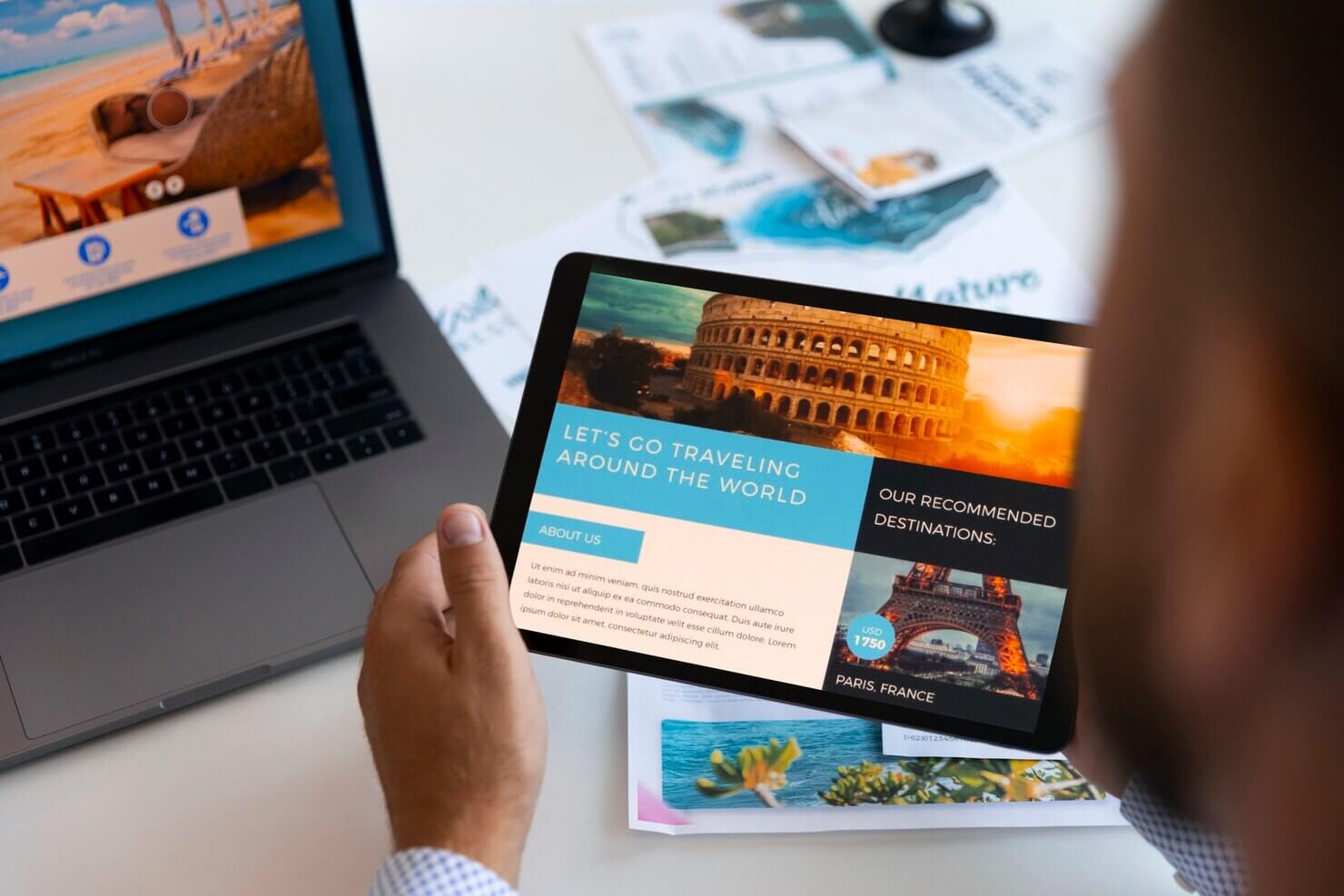Are you wondering whether a one-page website is worth it? Do you wonder if there is any value in it? Well, we are here to convince you there are multiple benefits of a one-page WordPress website. Check it out down below.

Let’s delve into the undeniable benefits of adopting a one-page WordPress website. As businesses and individuals seek to captivate their audience in a digital world that moves at an unprecedented pace. The concept of simplicity has emerged as a powerful ally. Enter the one-page WordPress website—a minimalist approach to web design that is rapidly gaining traction and reshaping the way we perceive and interact with online content.
One-page websites offer from enhanced user experience to improved search engine optimization. We explore how this design philosophy is not merely a trend but a strategic choice for those who seek to make a lasting impact in the crowded online realm. Join us on a journey of discovery as we uncover the benefits that await those who choose simplicity in the form of a one-page WordPress website.
What is a one-page site?
A one-page website, also known as a single-page website, is a type of website that consists of only one HTML page. Unlike traditional multi-page websites with multiple interconnected pages, a one-page website condenses all its content into a single, vertically scrolling page. Users navigate through the content by scrolling down or by using navigation links that jump to different sections of the page.
One-page websites are developed and commonly used for portfolios, personal websites, event pages, product launches, or any situation where concise and focused content presentation is desired. While they have certain advantages, such as ease of navigation and a streamlined user experience, they may not be suitable for content-heavy websites or those with complex navigation requirements.
Why is a one-page site worth it?
Single-page websites are typically simple and focused, presenting all the essential information in a streamlined manner. This can be beneficial for businesses or individuals who want to convey a specific message without overwhelming the user with multiple pages. On the site, you can see all the information on the products and services.
Navigation is often achieved through vertical scrolling, where users scroll down the page to access different sections or content. There is less guessing by the user and a simple search will be easy to find.
Some designers and businesses prefer the aesthetic appeal of single-page websites. They can be visually striking and make a strong impression when designed effectively. The addition of interactive features improves the user experience of the website.
One-page websites are commonly used for:
- portfolios,
- personal websites,
- event pages,
- product launches,
- or any situation where concise and focused content presentation is desired.
11 Benefits of a one-page WordPress website
Let’s examine some of the benefits of a one-page WordPress website. Some of these benefits include it enables you to get creative with your storytelling to inspire action. Moreover, single pages convert faster and load quickly. Furthermore, single-page sites also lower bounce rates and are easier to edit. Also, one-page sites tend to be more attention-grabbing due to their concise nature. These are just some benefits of a one-page WordPress website. Let’s explore these and more in detail below.

Get creative with your storytelling to inspire action
One-page websites force you to get creative with your storytelling. A one-page website offers a unique canvas for creative storytelling by providing a concise yet impactful space to engage visitors. Unlike multi-page websites, where information is categorized and navigation can distract from the narrative flow, a single page allows for a seamless and immersive storytelling experience. With limited space, creators must distill their message to its essence, fostering clarity and focus.
The linear progression of content on a one-page site guides the audience through a carefully crafted narrative journey, enhancing the overall storytelling impact. This format encourages inventive design choices, such as:
- parallax scrolling,
- interactive elements,
- and visually striking layouts,
enabling storytellers to captivate their audience with a memorable and immersive digital experience.
The simplicity of a one-page website challenges creators to prioritize key elements, fostering a more profound connection between the story and the audience. In essence, a one-page website becomes a dynamic and versatile platform that empowers creativity, allowing storytellers to weave compelling narratives in a visually captivating manner.
Scrolling has become second nature
Scrolling has evolved into a second-nature interaction on the web due to a confluence of factors that have reshaped user behavior and design trends. The ubiquity of smartphones and tablets has played a pivotal role. The touch-based nature of these devices makes scrolling an intuitive and seamless method of navigating content.
Additionally, the prevalence of infinite scrolling, popularized by social media platforms, has conditioned users to expect a continuous flow of information as they scroll down a page. This method not only facilitates a smooth and uninterrupted browsing experience but also aligns with the preference for efficiency in information retrieval.
The standard of responsive design, catering to a diverse array of screen sizes, has further solidified scrolling as a versatile and user-friendly navigation tool. In the context of one-page websites, scrolling presents several advantages. It allows for a linear and immersive storytelling experience. Therefore, guiding users through a cohesive narrative or presenting a product/service in a structured manner. The simplicity of scrolling complements the modern aesthetics often associated with one-page sites, contributing to a clean and visually appealing design.
By consolidating all essential information on a single page, one-page sites streamline navigation, reduce loading times, and enable designers to focus on key messages. The amalgamation of these factors underscores why scrolling has become ingrained in user habits and why it is particularly advantageous when crafting a one-page website.

You can’t overcomplicate your message on a single-page website
In one-page websites, simplicity is not just a virtue but a necessity. The limited space available demands that messages be concise and easily digestible. Overcomplicating your message can quickly overwhelm visitors, leading to a loss of interest and potential engagement. To maintain clarity on one-page sites, it’s crucial to focus on the essentials.
Here are our three tips:
- Firstly, streamline your content by distilling your key message into a single, compelling sentence that succinctly communicates your purpose.
- Secondly, employ visual elements judiciously to enhance understanding and engagement without cluttering the landing page.
- Finally, ensure a straightforward navigation flow, guiding users seamlessly through the information you present.
By adhering to these three tips, you can strike a balance between conveying your message effectively and preventing information overload.
Conversely, the consequences of a complicated message on a single-page website can be severe. Visitors may become frustrated or confused, resulting in high bounce rates as users abandon the site due to the cognitive load of deciphering convoluted information.
A cluttered layout and convoluted messaging can diminish the user experience. Thus tarnishing the brand’s image and reducing the likelihood of achieving desired outcomes. Outcomes such as conversions or engagement. In the digital landscape where attention spans are fleeting, simplicity captures attention and ensures that the audience comprehends and retains the essential information. Thus fostering a positive interaction with the website.
Single-page websites convert faster if done properly
A single-page website often boasts a higher conversion rate compared to a multipage site due to its streamlined and focused nature. The simplicity of a single page eliminates the need for users to navigate through multiple sections, reducing the risk of distractions or confusion.
Visitors are presented with a cohesive narrative, allowing for a more controlled and targeted user experience. This can be particularly effective when the goal is to drive a specific action, such as making a purchase or signing up for a newsletter. With all relevant information condensed onto a single page, users are more likely to absorb the key messaging and promptly take the desired action, as the conversion process is inherently more straightforward.
To enhance the conversion rate of a single-page website, it’s crucial to optimize the content and design for maximum impact. Use compelling headlines, concise copy, and engaging visuals to convey the key messages concisely. Employ strategic call-to-action (CTA) buttons that stand out and guide users seamlessly through the conversion funnel.
Implementing a responsive and user-friendly design is also essential, ensuring that the page is accessible and visually appealing across various devices. Additionally, leverage storytelling techniques to create a compelling narrative that resonates with the target audience, reinforcing the value proposition and motivating users to take the desired action. Regularly test and analyze the site’s performance, making data-driven adjustments to further optimize the conversion process over time.

A one-page website can work well across all devices
A one-page website can work well across all devices due to its simplicity and streamlined design. By consolidating all essential information onto a single page, users can easily navigate and access content regardless of the device they’re using.
This responsive approach ensures a consistent and user-friendly experience on desktops, tablets, and smartphones. With fewer elements to load and render, one-page websites often have faster loading times, contributing to a smoother browsing experience. The design’s adaptability to various screen sizes allows for a seamless transition between devices, making it an efficient choice for users who want quick access to information without the need for complex navigation.
A mobile-first or mobile-friendly website is crucial for Google algorithms because of the search engine’s emphasis on providing a positive user experience, especially for mobile users. Google prioritizes mobile-friendly websites in its rankings, recognizing the increasing trend of users accessing the internet via mobile devices.
A mobile-first approach involves designing and optimizing a website for mobile devices before considering desktop versions. Google’s algorithms take into account factors like mobile responsiveness, page load speed on mobile devices, and overall mobile usability when determining search rankings. Given the growing number of mobile users, having a website that caters to their needs aligns with Google’s goal of delivering high-quality and relevant content to users. Ultimately influencing search engine rankings positively.
There is less to manage and maintain
A single-page website offers the advantage of streamlined simplicity, requiring less management and maintenance compared to multi-page counterparts. With all content consolidated onto the same page, updates and modifications can be executed efficiently. Thus ensuring a cohesive and synchronized user experience.
The absence of intricate navigation structures and interconnected pages reduces the complexity of the website. Therefore making it easier to monitor and manage. This simplicity not only accelerates the development process but also minimizes the likelihood of errors or broken links, contributing to a more seamless and hassle-free maintenance routine.
Additionally, the straightforward structure of a single-page website facilitates:
- quicker loading times,
- enhancing user engagement
- and user satisfaction.
Overall, the simplicity inherent in a single-page design translates into a more manageable and low-maintenance web presence, particularly beneficial for small businesses, portfolios, or projects with concise content and clear objectives.
Do you want to check the health of your website?

Lower bounce rate
Lower bounce rates on one-page websites can be attributed to several factors that enhance user experience and engagement. A bounce rate is the percentage of visitors who navigate away from a website after viewing only one page. One-page websites, also known as single-page websites, present content on a single, scrollable page rather than through multiple pages.
How does a single-page site contribute to a lower bounce rate?
Here’s why they can contribute to a lower bounce rate:
- One-page websites typically have a straightforward structure with all the content accessible through scrolling. This simplicity in navigation reduces the chances of visitors getting confused or frustrated with complex menus and multiple pages.
- Since one-page websites have fewer elements to load compared to multi-page websites. Thus they often have quicker loading times. Fast loading speeds contribute significantly to a positive user experience. Visitors are more likely to stay on a site that loads quickly. Therefore, reducing the likelihood of bouncing.
- They are well-suited for linear storytelling or presenting a cohesive narrative. Instead of spreading content across different pages, everything is laid out sequentially. This can captivate visitors and encourage them to scroll through the entire page to absorb the complete story or message.
- One-page websites can strategically place call-to-action (CTA) elements throughout the page. By placing these elements at strategic points, such as after presenting key information or at the end of a story, users are more likely to respond to the CTA. Once again reducing the bounce rate.
- Finally, a well-designed one-page website guides users through a focused and predetermined journey. Since there are no external links to distract visitors, they are more likely to stay on the page. Users will follow the intended path, resulting in a lower bounce rate.
It’s important to note that while one-page websites can contribute to a lower bounce rate. Their suitability depends on the type of content and goals of the website. For certain purposes, such as portfolios, event promotions, or product showcases, one-page websites can be highly effective. They can keep visitors engaged and minimize bounce rates.

Making changes to the site is easier
A single-page website is easier to edit than a multi-page site. Making changes on multiple landing pages can be time-consuming. Editing one-page websites is usually the click of a few buttons or typing a line or two on the keyboard. It is not as task-intensive, as a multi-page website. This is typically due to several reasons, such as:
- One-page websites typically have a straightforward structure with minimal content. This simplicity makes it easier to locate and edit specific elements without navigating through multiple pages.
- One-page websites often focus on a single topic or purpose, leading to concise and concentrated content. This reduces the overall amount of information that needs to be managed and edited.
- Since everything is on a single page, updates can be made quickly without the need to synchronize changes across different pages. This can be advantageous for time-sensitive information or frequent updates.
- Traditional multi-page websites might require a more complex navigation structure and involve multiple interconnected elements. In contrast, one-page websites have a linear structure, simplifying the editing process.
WordPress maintenance and updates for one-page websites can be more cost-effective. This is especially true for small businesses or individuals who may not have the resources to manage a complex multi-page site.
Easier to optimize in terms of speed
Another one of the many benefits of a one-page WordPress website is it loads very quickly. The longer people wait to load your site, the higher their chances of leaving. Nonetheless, one-page sites load faster because they require less space to load. Some other reasons why a one-page website may load quickly include:
- One-page websites typically have fewer resources (images, stylesheets, scripts) to load since all the content is on a single page. Each resource requires a separate HTTP request, and reducing the number of requests can significantly speed up page loading.
- One-page websites can benefit from more effective caching strategies. Once the user has loaded the page, subsequent visits or interactions may not require the re-download of all resources, as they can be stored in the browser cache.
- One-page websites often have simpler code structures. The absence of complex navigation and multiple page elements can result in cleaner and more optimized code, which improves rendering and loading times.
- Since there’s only one page to request and load, the server response time is often minimized. This is because the server doesn’t have to process multiple requests for different pages, which can contribute to faster loading times.
It’s important to note that while one-page websites may load faster in some cases, the overall user experience also depends on factors like the efficiency of coding, server performance, and the user’s device and internet connection.
Tips to optimize a one-page site
Some tips for optimizing a one-page WordPress site include:
- Optimize images & media files. Compress and resize images to reduce file size without compromising quality. Use the appropriate file format such as WebP. You may also consider leveraging lazy loading to load images only when they are about to be displayed.
- Prioritize Above-the-Fold Content. Make sure to load critical content, especially above-the-fold content, first. This ensures that users see important information quickly, even if the entire page hasn’t finished loading.
- Load non-essential JavaScript asynchronously to prevent it from blocking the rendering of the page. You may also consider minifying CSS, JavaScript, and HTML files to remove unnecessary spaces and comments.
- Use a responsive design. Ensure your one-page website is optimized for various devices and screen sizes using responsive design principles.
By following these tips and regularly assessing your website’s performance, you can create a fast and efficient one-page website that provides a positive user experience.

No clutter & more attention-grabbing
A single-page website design can offer a refreshing departure from cluttered and overwhelming online experiences, providing a streamlined platform that captivates attention more effectively. By consolidating information onto a single page, users are spared the confusion of navigating through a multi-page website, allowing for a more seamless and focused browsing experience.
The concise nature of a one-page website encourages visitors to engage with the content more attentively, as there are no distractions or detours to divert their attention. To achieve this:
- firstly, prioritize essential information and present it in a clear and organized manner, ensuring that the most crucial details are readily accessible.
- secondly, leverage visually striking elements such as compelling images, concise headlines, and interactive features to make the content visually appealing and engaging.
This streamlined approach not only enhances user experience but also facilitates a more memorable and impactful online presence, making it another of many notable benefits of a one-page WordPress website.
The single-page WordPress development process is much faster
The process of developing a single-page website is generally faster than creating a multipage website due to its streamlined and concise nature. In a single-page website, all the content is contained within a single HTML file, which simplifies the development process and reduces the need for navigating through multiple pages.
This cohesive structure allows for quicker design and implementation of the user interface, as there are fewer components to manage and integrate. Additionally, the reduced number of pages results in a more straightforward navigation system, minimizing the time spent on creating complex site structures and interlinking pages. Single-page websites are often favored for projects with a specific focus or limited content, enabling a more rapid development cycle without sacrificing functionality or aesthetics.

TL;DR: Concluding the advantages of a single-page site
In conclusion, embracing a one-page WordPress website offers a multitude of benefits that cater to the evolving needs of today’s online audience. With scrolling becoming second nature, users effortlessly navigate through seamless content, ensuring a lower bounce rate and increased engagement. The streamlined nature of a single-page design not only enhances user experience but also facilitates easier optimization for speed, a critical factor in retaining visitors.
As we strive for digital simplicity and user-friendly interfaces, the one-page WordPress website emerges as a powerful tool for businesses and individuals alike. It’s not just a trend; it’s a strategic move towards an efficient, captivating online presence.
Ready to elevate your web presence and captivate your audience with a one-page WordPress website? Drop us a line, and let’s embark on a journey of streamlined design and unparalleled user experience. Your online success awaits – make it happen with a single scroll.
Comments